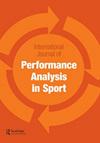Comparison of training activities and coaching behaviours in youth football coaches from Spain and China: a case study
IF 1.6
4区 教育学
Q1 Health Professions
International Journal of Performance Analysis in Sport
Pub Date : 2023-06-22
DOI:10.1080/24748668.2023.2227924
引用次数: 0
Abstract
ABSTRACT Youth football training should ensure proper player development. However, coaches worldwide behave differently during their coaching process. Thus, this study aims to: a) compare the coaching behaviour and training activities of the football coaches from China and Spain, and b) explore the impact of different pedagogy on coach’s behaviour and players’ perceptions. Systematic observations and semi-structured interviews were developed for 6 youth coaches from Madrid (n = 3) and Beijing (n = 3). And 16 players randomly selected from each academy were queried their perception. The results showed significant differences in coaching behaviours and training activities between both groups. Madrid coaches used more “playing form” (PF) and achieved greater times of activation (motor participation) during practices, compared to Beijing coaches. Concurrent-instruction was the most used behaviour among coaches from both groups. Moreover, Madrid coaches applied more “positive feedback” whereas Beijing coaches used more “negative feedback”. This phenomenon is related to different educational and pedagogical backgrounds. Positive feedback is recommended to Beijing coaches and “silence” should also be properly used while “instruction” and “hustle” should be carefully used to help players learn to “think” (e.g. decision-making). This study offers a comparative analysis to develop proper strategies for a better player’s development.西班牙和中国青少年足球教练员培训活动和教练行为的比较:个案研究
摘要青少年足球训练应确保球员得到适当的发展。然而,世界各地的教练在执教过程中表现不同。因此,本研究旨在:a)比较中国和西班牙足球教练的教练行为和训练活动,以及b)探讨不同的教学法对教练行为和球员认知的影响。对来自马德里(n = 3) 和北京(n = 3) 。从每个学院随机挑选的16名球员被问及他们的看法。结果显示,两组在辅导行为和训练活动方面存在显著差异。与北京教练相比,马德里教练在训练中使用了更多的“比赛形式”(PF),并获得了更多的激活次数(运动参与)。同时指导是两组教练中最常用的行为。此外,马德里队的教练使用了更多的“正反馈”,而北京队的教练则使用了更多“负反馈”。这种现象与不同的教育和教学背景有关。建议北京队教练给予积极的反馈,也应适当使用“沉默”,同时应谨慎使用“指导”和“忙碌”来帮助球员学会“思考”(如决策)。本研究提供了一个比较分析,以制定适当的策略,更好地发展球员。
本文章由计算机程序翻译,如有差异,请以英文原文为准。
求助全文
约1分钟内获得全文
求助全文
来源期刊

International Journal of Performance Analysis in Sport
SPORT SCIENCES-
CiteScore
4.70
自引率
4.80%
发文量
38
审稿时长
>12 weeks
期刊介绍:
The International Journal of Performance Analysis in Sport aims to present current original research into sports performance. In so doing, the journal contributes to our general knowledge of sports performance making findings available to a wide audience of academics and practitioners.
 求助内容:
求助内容: 应助结果提醒方式:
应助结果提醒方式:


